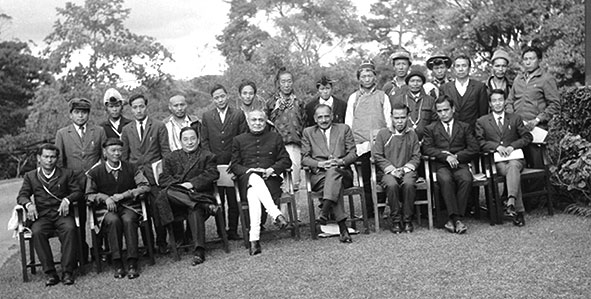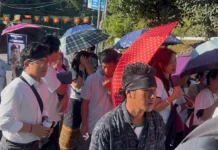
[ Dani Sulu ]
Come 20 January, 2022 and a grand celebration is on the offing to commemorate the golden jubilee of the birth of Arunachal Pradesh as a distinct political, administrative and geographic identity. As a culmination of the process started by the founding fathers of Arunachal Pradesh in its various meetings, endeavours, and resolutions taken up as members of NEFA agency council, the erstwhile North Eastern Frontier Agency was renamed as Arunachal Pradesh and declared as a separate union territory on a sunny wintry day at Ziro on 20 January, 1972 by Indira Gandhi, the then prime minister of India. The gazette notification to this effect was published by the government of India on 21 January, 1972. The rest is history, and today we live to enjoy the fruits of the seeds sown by the founding fathers of Arunachal Pradesh who had decided to take the destiny of our state in our hands. Arunachal Day was celebrated on 20 January every year till 1986. On attaining statehood on 20 February, 1987, the Arunachal Day celebration of 20 January was replaced by the Statehood Day on 20 February every year.
Coming back to the D-Day of 20 January, 1972, people from all over Arunachal Pradesh had dared the arduous and difficult journey over hills and mountains, over the backs of mules and rickety old trucks to witness the historic event. The day was ear biting cold, but the spirit of the people of Arunachal was higher, to be part of and witness the historic moment of the birth of Arunachal Pradesh. The dance troops and pageant groups of different tribes of the then NEFA were present on the occasion to showcase the rich and beautiful hues and colours of different cultures and customs that cohabited with each other within Arunachal over the centuries.
But who these founding fathers were and how Arunachal Pradesh came into being and get its name has been lost in the mists of frozen memories. Who were these pioneers whose voices moulded the divergent cultures, traditions and ethos of different tribes into one Arunachal community with a common vision, aspiration and expectations?
Let me try to take you all fifty years down the memory lane and lift the veil off the clouded memories and introduce these humble personalities who with great foresight, vision and sagacious mind ushered the once unknown geographical expression of our state into a modern state with a representative of government by its own people and left a rich legacy to which the subsequent generations’ leaders, at times, have been found to be wanting.
These founding fathers of Arunachal Pradesh were the members of the agency council which was formed in December 1969 and functioned like that of legislative assemblies of other states. This historic day of 20 January, 1972 was the culmination of the decision taken by the agency council members in its first sitting on 3 December, 1969, in Shillong to have the capital of the NEFA within the NEFA instead of Shillong. They also decided to have their own identity in terms of political, administrative and geographical entity with a proper name.
The foundation day of Arunachal Pradesh on 20 January, 1972 was blessed by the presence and speeches of legendary leaders of different districts and tribes like late Kabang Borang, agency councillor from Siang, late Dani Kunia, agency councillor from Lower Subansiri, late Ita Pulu, agency councillor from Lohit district, late Todak Basar, agency councillor from Siang, and many others who lit the lamp of representative form of government in Arunachal Pradesh and under whose light we have walked miles and miles towards better and progressive Arunachal as a society and as a state till today.
The agency council was the apex body of the first representative form of self-governance in Arunachal Pradesh which was known as the NEFA at the time. The NEFA panchayati raj system started with gram panchayats at the village level who elected anchal samiti members amongst themselves and the anchal samiti members elected vice presidents of anchal segments and also members of zilla parishads from amongst themselves. The vice presidents of the anchal segments and elected members of the zilla parishads (ZPM) elected the district vice presidents who were ex officio members of agency council. In addition, three more members were elected from amongst the vice presidents and elected members of zilla parishads as members of the agency council. Hence, the five districts of Tirap, Lohit, Siang, Subansiri and Kameng of the then NEFA sent four representatives each to the agency council. The first elections to panchayat bodies under the NEFA Panchayati Raj Regulation, 1967 was held in 1969 and the agency council was formed and convened on 3 December, 1969.
With the inauguration of the first agency council session by BK Nehru, the then governor of Assam, on 3 December, 1969, democracy took root in the NEFA permanently.
BK Nehru in his inaugural speech said: “It is my happy privilege to welcome today the members of the agency council of the NEFA administration. The third December 1969 will go down in the history of the administration as a red letter day for it marks the beginning of the exercise of statutory power by the people of the agency council to manage their internal affairs. It also provides a landmark in the constitutional growth of this territory. The members of the agency council who have met here today are, therefore, pioneers of a new phase of political advancement of their people.”
The agency council was entrusted with functions which were almost corresponding to those of legislative assemblies of the states. The members of the agency council were:
- BK Nehru: The governor of Assam (chairman).
- Daying Ering: NEFA member of parliament.
- PN Luthra: Advisor to the governor of Assam.
- Wangmai Rajkumar: Vice president, Tirap zilla parishad.
- Khengman Longsam: Elected member, Tirap zilla parishad.
- Mowang Wangham: Elected member, Tirap zilla parishad.
- Hengwang Lowang: Elected member of Tirap zilla parishad.
- Ita Pulu: Vice president Lohit zilla parishad.
- Chewpak Gohain: Elected member of Lohit zilla parishad.
- Senge Kri: Elected member of Lohit zilla parishad.
- Gora Pertin: Elected member of Lohit zilla parishad.
- Todak Basar: Vice president, Siang zilla parishad.
- Kabang Borang: Elected member of Siang zilla parishad.
- Sutem Tasung: Elected member of Siang zilla parishad.
- Tamar Karlo: Elected member of Siang zilla parishad.
- Tapang Gyama: Vice president, Subansiri zilla parishad.
- Doni Kunya: Elected member of Subansiri zilla parishad.
- Nabam Rungkhi: Elected member of Subansiri zilla parishad.
- Gangte Taki: Elected member of Subansiri zilla parishad.
- Rinchin Namze: Vice president of Kameng zilla parishad.
- Tsewang Norbu: Elected member of Kameng zilla parishad.
- Prem Dorjee: Elected Member of Kameng zilla parishad.
- Naibili Dusisu: Elected member of Kameng zilla parishad.
One of the important subjects discussed by the council in its first session itself was the need for the NEFA to have its own headquarters and selection of a site for its location within the NEFA. A search committee to suggest the capital of the NEFA from amongst the agency councillors was formed, which visited the probable sites of Basar, Banderdewa, Lule Sijak and Yachuli.
The all-important and game changing decision to change the name of the NEFA to Arunachal Pradesh was taken during its second session at Shillong on 10 and 11 August, 1970. The council had three alternatives for consideration, which were Arunachal, Udayachal and Bramha Mandal. After detailed discussion, the council unanimously resolved that the NEFA should be named Arunachal Pradesh – a land of rising sun. Another important resolution adopted was the introduction of English medium of school education instead of Assamese medium. The council unanimously resolved that English should be made the medium of instruction in education institutes of the NEFA. This was forwarded for the approval of the government of India. The council also unanimously decided that the member of parliament from the NEFA should be indirectly elected by the people of Arunachal Pradesh for the purpose of the 1972 elections, instead of being nominated by the government of India through the governor of Assam. The council also took up the resolution for opening up public schools and open schools across the NEFA.
The third, fourth and fifth sessions of the agency council were held on 6-7 February, 1971, 12-13 August, 1971, and 28 February, 1972 at the Raj Bhavan in Shillong under the chairmanship of BK Nehru, the then governor of Assam, Nagaland and Meghalaya.
The council took many important decisions during its sessions which had long-lasting effects in the growth of Arunachal as a union territory and then as a full-fledged state.
One of the most notable decisions that saved Arunachal Pradesh from turning into another Tripura, to be flooded and inundated by refugees, outsiders, foreigners and ex-serviceman, was the decision of the council to stop settling of refugees and ex-servicemen in the NEFA. Until then, the government of India saw Arunachal as a virgin ground for dumping and resettling the refugees from Bangladesh and Tibet and the ex-servicemen. Many Chakmas, Hajongs, Tibetans and ex-servicemen were settled in the then NEFA, whose presence is still resented today by the people of Arunachal Pradesh. As per the records available, late Dani Kunia, agency council member from Subansiri, in one of its sessions proposed that no more refugees and ex-servicemen should be settled in the NEFA. This resolution was unanimously adopted by the agency council, which was accepted by the government of India. Since then, no more outsiders, refugees and ex-servicemen were settled in Arunachal Pradesh. But for this historic and game changing resolution adopted by the agency council, the fragile and innocent people of Arunachal Pradesh would have fallen prey to the more numerous settlers from mainland India and refugees from other countries. Perhaps the AAPSU, which is spearheading the movement against illegal settlement of refugees and outsiders, and the people of Arunachal need to recognize the role of these founding fathers for keeping Arunachal safe for the generations to come with their farsighted and wise decision to resolve not to allow anymore resettlement of refugees and ex-servicemen.
The other important resolution adopted by the agency council was to introduce English medium education system and affiliate the schools in Arunachal Pradesh with the Central Board of Secondary Education and introduce NCERT books instead of Assamese medium and Assam board. The decision to protect Arunachal’s indigenous culture and custom, to connect all the districts and their headquarters with all-weather roads, to get a separate union territory of its own and selection of Itanagar as capital of the newly formed Arunachal Pradesh were the decisions that shaped and firmed up Arunachal and its people as one family in spite of vast geographical and cultural differences.
The last meeting of the agency council was held on 28 February, 1972 in Shillong. Indira Gandhi arrived in Shillong on 28 February, 1972 and declared Itanagar as the capital of Arunachal Pradesh in the penultimate session of the agency council. Later in the evening, BK Nehru, the then governor of Assam, held a farewell banquet for the outgoing agency council members. Thus, with the birth of Arunachal Pradesh as a union territory on 20 January, 1972 and declaration of Itanagar as its capital on 28 February, the first pioneering leaders of Arunachal society gave way to a new form of governance and passed on the baton of leadership to the younger batch of leadership. The next election to the panchayat bodies took place during April-May 1972 and on 1 Ausgust, 1972, the agency council reincarnated itself as the pradesh council, which further reincarnated itself as a provisional legislative assembly on 15 August 1975. The members of the pradesh council were re-designated as members of the provisional legislative sssembly. They took up the baton passed on by the pioneering leaders as the NEFA agency council members. The story of the pradesh council and how it took up the challenge in shaping up the nascent Arunachal Pradesh is another story to be told in the coming days as Arunachal Pradesh gears up to commemorate the golden jubilee of Arunachal’s founding day on 20 January, 2022.
All the members of the agency council have passed away and are no more with us, and memories of their heroic and epoch making roles have also been lost in the mists of times. But their deeds, visions and legacies still speak to us in silence and guide the people of Arunachal Pradesh through the conscientious vibes that keep us as one unit and one family – a grand Arunachal family.
On the occasion of the fiftieth year of Arunachal Pradesh coming into being, this article is dedicated to the unsung founding fathers of Arunachal Pradesh, the agency council members, of whom my late father, Dani Kunia, was also a member from 1969 to 1972.
On 28 February, Indira Gandhi, the then prime minister of India, declared Itanagar as the capital of the newly formed union territory of Arunachal Pradesh from Shillong, Megalaya. After the declaration, the fifth and the last session of the agency council was held on the same day at the Raj Bhavan in Shillong, which was followed by a group photo and a banquet hosted by BK Nehru, the then governor of Assam, in honour of the agency council members.
NB: I, Dani Sulu, wrote this article on 2 January, 2022. I have sourced the information contained herein mainly from the NEFA Information Journal which was published by the NEFA administration. I have tried to verify the correctness of the information from various parallel sources. So, if there is any mistake, I stand to be corrected. No part of this article may be doctored or edited and re-circulated as it has the potential to disseminate wrong information. This article may be shared as a whole without doctoring/re-editing for the students as well as general public who want to know about the initial political history of Arunachal Pradesh.




